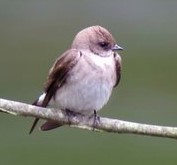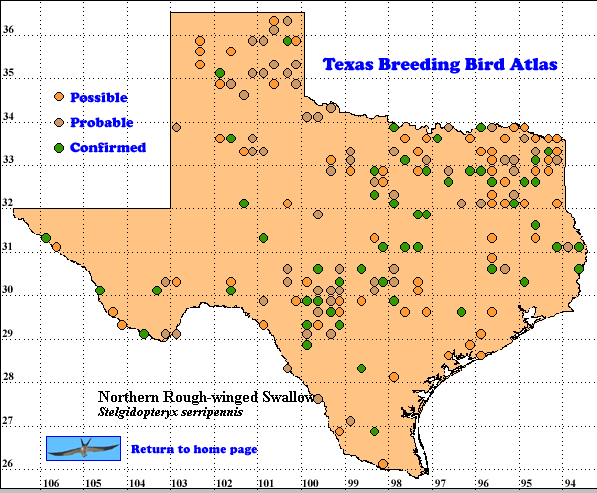The Northern Rough-winged Swallow occurs as a breeding bird across much of temperate North America and through the highlands of Middle America. It ranges from southeastern Alaska, central British Columbia, southern Alberta, southern Saskatchewan, southern Manitoba, western and southern Ontario, southwestern Quebec, central Maine and southwestern New Brunswick south to southern Baja California, Oaxaca, Vera Cruz, in the Middle American highlands through Chiapas, Guatemala, western Belize, El Salvador, Honduras and Nicaragua to Costa Rica, and to southern Texas, the Gulf Coast, and south-central and southwestern Florida (A.O.U. 1998). As the species also winters irregularly in southern Texas, the species may be encountered throughout the year in that part of the state.
This swallow is both a solitary and semi-colonial nester. It may, in fact, nest in Bank Swallow (Riparia riparia) colonies. More often, however, one to several pairs will nest along the bank of a stream or river or perhaps in a cut along a road. J.C. Newnam and A.L. Barr (pers. comm.) found rough-wings nesting in drain holes in the dam at Lake Somerville (30096-C5) in 1974; the nests were subsequently washed out by heavy rains that raised the lake level significantly. R. Kinney (pers. comm.) reported a similar situation in which rough-wings nested in holes in the concrete walls of the spillway at Lake Tawakoni (32095-G8).
The T.O.S. Check-list (1994) reports two subspecies as breeding in Texas: Stelgidopteryx s. serripennis breeds throughout much of Texas east of the Pecos River; S. s. psammochrous breeds along the Rio Grande from Brewster County to El Paso County and perhaps elsewhere in the Trans-Pecos region.
DISTRIBUTION: The TBBA data showed that the Northern Rough-winged Swallow was confirmed as breeding in every ecological region in Texas. These data included one or more records for all but 14 of the Texas latilongs; several of these were latilongs in which access was difficult or in which a low rate of effort occurred. Atlas data confirmed nesting in 33 latilongs. In the Trans-Pecos region, the majority of the records come from along the Rio Grande (latilongs 31105, 30104, 29104, and 29103). The paucity of records from the remainder of that region and from the Southern Great Plains and the western Edwards Plateau probably reflects the low number of watercourses in those regions (or lack of access by atlasers). This differs significantly from Oberholser (1974) which portrayed the species as nesting in the Trans-Pecos only in the Big Bend area and as absent as a breeder from the High Plains south to the South Texas Plains and from the piney-woods of east Texas. Similarly, the T.O.S. Check-list (1994) lists this swallow as absent as a breeder from most of the South Plains and from the Rolling Plains. Rappole and Blacklock (1985) consider this species as a migrant in the Coastal Bend region, while Pulich (1988) lists nesting in eight counties, with suspected breeding in two others, among the 32 counties he includes in north-central Texas.
SEASONAL OCCURENCE: Because this swallow breeds in burrows, it becomes difficult to confirm the presence of eggs or young, unless one makes repeated trips to a known burrow to observe adults carrying food to young in the burrow. Despite this difficulty, the 246 TBBA records include 63 confirmed reports (25.6%).
Oberholser (1974) reports breeding as occurring in Texas from late March to early July, with extreme egg dates of 11 April to 21 June. The earliest confirmed nest (nest building) in the TBBA data set is 3 April from latilong 29099 (quad C1), while the latest date for that is 21 May in latilong 33094 (quad B6). However, Richard Kinney reported that swallows still on the nest on 8 May 1988, had arrived on 28 February that year! The latest date for adults “on nest” or “nest with young” is 24 June (29099, quad C8) and 15 July (35100, quad H3), respectively, yet a report from latilong 32094 (quad F7) lists “feeding young” on 27 July!
BREEDING HABITAT: Most reports of nests for rough-winged swallows are for burrows constructed in the banks of rivers and streams or in cuts along roads. Yet, the species will use man-made structures as indicated for Lakes Somerville and Tawakoni. The birds construct their burrows in exposed banks, usually near the top of the bank. After digging a burrow two to four feet into the bank, the swallows excavate a nest chamber which may have dry grass or other vegetation as a lining. New burrows are constructed each breeding season (Oberholser 1974).
STATUS: The Northern Rough-winged Swallow is a much more common breeding bird in Texas than pre-TBBA data would indicate. In general, the TBBAP data show a much broader distribution in Texas than indicated in The Bird Life of Texas (Oberholser 1974) or in the Check-list of the Birds of Texas (T.O.S. 1994). TBBAP efforts show probable or confirmed nesting for virtually every part of the state. Indeed, many contributors commented on the long-time presence of this swallow within their area and questioned the need for making this swallow an “asterisked species” (i.e. details needed).
Text by Keith A. Arnold (ca. 1999)
Literature Cited
American Ornithologists’ Union. 1998. Check-list of North American birds. 7th ed.. American Ornithologists’ Union, Washington, D.C.
Oberholser, H. C. 1974. The Bird Life of Texas. University of Texas Press, Austin, Texas.
Pulich, W. M. 1988. The Birds of North Central Texas. Texas A&M University Press, College Station, Texas.
Rappole, J. H. and G. W. Blacklock. 1985. Birds of the Texas Coastal Bend, Abundance and Distribution. Texas A&M University Press, College Station.
Texas Ornithological Society. 1994. Checklist of the birds of Texas. 3rd ed. Texas Ornithological Society, Austin.

